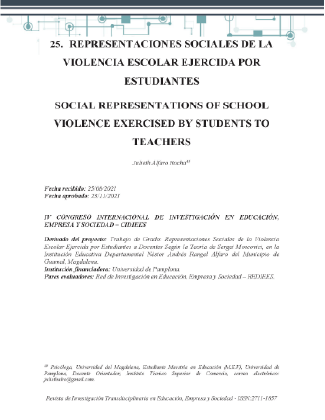XXV. SOCIAL REPRESENTATIONS OF SCHOOL VIOLENCE EXERCISED BY STUDENTS TO TEACHERS
##plugins.themes.bootstrap3.article.main##
Abstract
School violence is a phenomenon widely studied around the world. However, few are the approaches made when teachers are the victims and the students bullies. The present work aims to analyze the influence of the social representations about the manifestations of school violence, exercised by students to teachers in the I.E.D. Néstor Andrés Rangel Alfaro from the municipality of Guamal, Magdalena. At present there is no known research on the Social representations of school violence by students towards teachers in Colombia. The study has a qualitative approach and a phenomenological-hermeneutical design. Three professors from the institution participated, selected by intentional sampling, taking into account the principle of saturation of the sample. An interview was applied semistructured, taking as references the emerging categories of the theory of Moscovici and later validated by expert judges. The deductive coding technique was used and the thematic analysis was carried out with the Atlas.ti software. Four categories of analysis of social representation were established (objectification, anchoring, figurative aspect and dynamic aspect) and 24 codes were found, a starting from the analyzed stories. The central nucleus of the social representation was the verbal violence exerted by the students. Informants recognize school violence as a phenomenon in which they can be victims, they express a normalization of these behaviors at school, being violence of a verbal type the most frequent, producing stress, demotivation and apathy.
Download Statistics
##plugins.themes.bootstrap3.article.details##
Social representations, School violence, Victimization in Teachers





